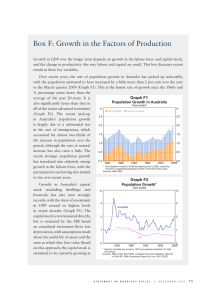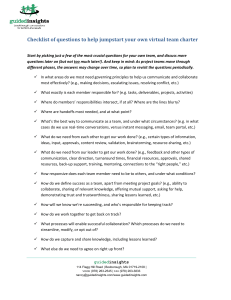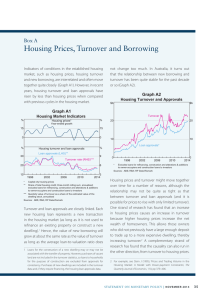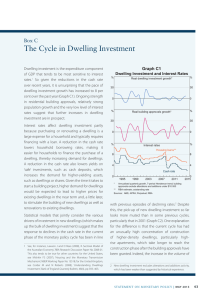The Housing Market Box B
advertisement
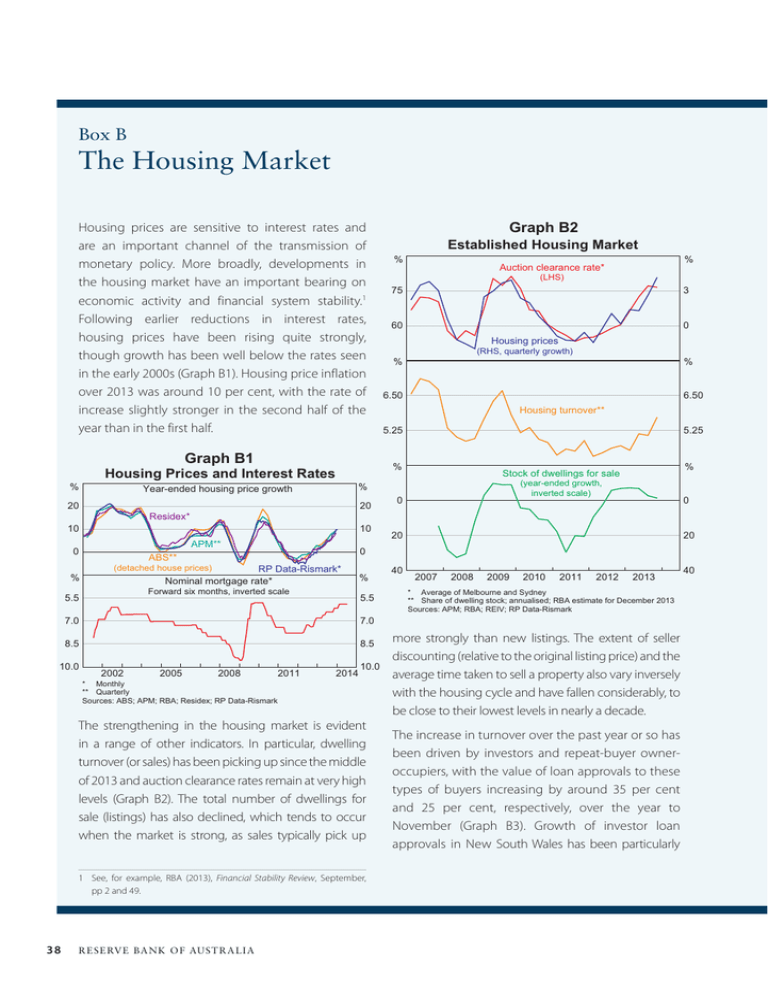
Box B The Housing Market Housing prices are sensitive to interest rates and are an important channel of the transmission of monetary policy. More broadly, developments in the housing market have an important bearing on economic activity and financial system stability.1 Following earlier reductions in interest rates, housing prices have been rising quite strongly, though growth has been well below the rates seen in the early 2000s (Graph B1). Housing price inflation over 2013 was around 10 per cent, with the rate of increase slightly stronger in the second half of the year than in the first half. Graph B1 % 20 Residex* 10 10 APM** % ABS** RP Data-Rismark* Nominal mortgage rate* Forward six months, inverted scale % 5.5 7.0 7.0 8.5 8.5 10.0 2002 2005 2008 2011 * Monthly ** Quarterly Sources: ABS; APM; RBA; Residex; RP Data-Rismark 2014 10.0 The strengthening in the housing market is evident in a range of other indicators. In particular, dwelling turnover (or sales) has been picking up since the middle of 2013 and auction clearance rates remain at very high levels (Graph B2). The total number of dwellings for sale (listings) has also declined, which tends to occur when the market is strong, as sales typically pick up 1 See, for example, RBA (2013), Financial Stability Review, September, pp 2 and 49. 38 R es erv e Ba nk of Aus t r a l i a (LHS) 3 75 60 0 Housing prices (RHS, quarterly growth) % % 6.50 6.50 Housing turnover** 5.25 5.25 % Stock of dwellings for sale (year-ended growth, inverted scale) 0 0 20 20 0 (detached house prices) 5.5 % Auction clearance rate* % Year-ended housing price growth 0 % % Housing Prices and Interest Rates 20 Graph B2 Established Housing Market 40 2007 2008 2009 2010 2011 2012 2013 * Average of Melbourne and Sydney ** Share of dwelling stock; annualised; RBA estimate for December 2013 Sources: APM; RBA; REIV; RP Data-Rismark more strongly than new listings. The extent of seller discounting (relative to the original listing price) and the average time taken to sell a property also vary inversely with the housing cycle and have fallen considerably, to be close to their lowest levels in nearly a decade. The increase in turnover over the past year or so has been driven by investors and repeat-buyer owneroccupiers, with the value of loan approvals to these types of buyers increasing by around 35 per cent and 25 per cent, respectively, over the year to November (Graph B3). Growth of investor loan approvals in New South Wales has been particularly 40 Graph B4 Graph B3 Housing Prices and Building Approvals Value of Housing Loan Approvals Ratio to value of the dwelling stock, quarterly % % Year-ended growth % (LHS) Repeat-buyer owner-occupiers* 0.8 % Private residential building approvals 0.8 50 30 Housing prices 0.6 0.6 25 0.4 0 0.2 -25 (RHS) 15 Investors 0.4 0 First home buyers 0.2 0 1997 2001 2005 2009 0 2013 -50 * Net of refinancing Sources: ABS; RBA strong at nearly 55 per cent over the year to November. In contrast, first home buyer demand for housing has been subdued, reflecting especially weak demand for established housing. The changes in state government incentives for first home buyers away from established dwellings and toward new dwellings has shifted their purchases accordingly. The rise in housing prices over the past year or so is broadly consistent with the historical relationship between interest rates and housing prices (see Graph B1). The reduction in interest rates has eased some financing constraints, reduced the user cost of housing and increased the attractiveness of investing in riskier, higher-yielding assets, resulting in stronger demand for residential property. Indeed, this effect of lower interest rates on housing prices is an important channel through which expansionary monetary policy supports economic activity. Increases in housing demand and prices boost dwelling construction as well as renovation activity (Graph B4). Higher housing prices and turnover also stimulate consumer spending by easing some home owners’ borrowing constraints and raising home owners’ perceptions of wealth. The demand for some real estate, legal and financial services also moves in tandem with housing transactions. -15 1993 1998 2003 2008 2013 -30 Sources: ABS; APM; RP Data-Rismark The upswing in housing asset values to date has not been fuelled by a rapid expansion in borrowing. Growth in housing credit is gradually picking up but remains relatively moderate and the ratio of households’ housing debt to income has been little changed at around 130 per cent (Graph B5). While the value of loan approvals has been rising strongly, this follows a period of weak growth and, as a share of the stock of housing credit, new loan approvals remain relatively low. Loan approvals tend to move closely with the value of dwelling turnover, which Graph B5 Housing Assets and Debt Per cent of annualised household disposable income* % 500 % 500 Housing assets 400 400 300 300 200 200 Housing debt 100 0 1993 1998 2003 100 2008 0 2013 * Household sector excludes unincorporated enterprises; disposable income is after tax and before the deduction of interest payments Sources: ABS; RBA S TATE ME N T O N MO N E TARY P O L ICY | F e b r ua r y 2 0 1 4 39 has picked up owing to both higher prices and turnover volumes. Nonetheless, to date, the rate of dwelling turnover has been a little below average (Graph B6 and Graph B2; see the ‘Domestic Financial Markets’ chapter for further details on developments in housing finance). R Graph B6 Housing Turnover and Loan Approvals Log scale $b $b Turnover 16 16 Loan approvals* 8 8 4 2001 2005 2009 * 2013 4 Excludes loans for refinancing, construction and alterations & additions by owner-occupiers, and construction loans by investors Sources: ABS; RBA; RP Data-Rismark 40 R es erv e Ba nk of Aus t r a l i a

